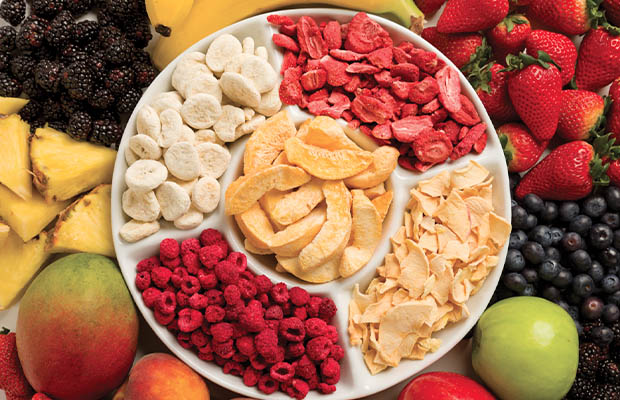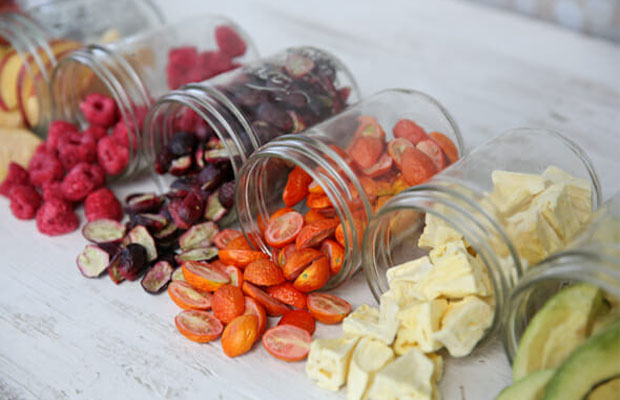The best drying technique is generally agreed to be freeze-drying. As a result, it is a customary practice in the pharmaceutical and food industries.
But do you know what is freeze-dried food? Freeze drying is the process of dehydrating frozen foods under a vacuum so the moisture content changes directly from a solid to a gaseous form without having to undergo the intermediate liquid state through sublimation.
This article goes into more detail about freeze-drying, discusses whether it is healthy, and offers advice for doing it at home.
Table of Contents
What is Freeze-drying?
A dehydration method based on the sublimation of water in a product is freeze-drying or lyophilization.
This indicates that the water content of the product changes directly from a solid to a gaseous state, or from ice to vapor, without passing through a liquid state.
Freeze-drying is considered a high-quality dehydration method for a couple of reasons, including:
- it operates at low temperatures, which contributes to preserving a product’s nutritional value, taste, appearance, and heat-sensitive compounds
- freezing inhibits chemical and microbiological processes, which significantly delays the product’s deterioration (thereby extending its shelf life)
How Does Freeze Drying Work?
Simply put, freeze-drying is the process of evaporating the water from a frozen product. When a frozen liquid sublimates, it stops going through the liquid phase and goes straight from frozen to gaseous. The freeze-drying procedure is divided into three stages: prefreezing, primary drying, and secondary drying.
Prefreezing:
It is necessary to prefreeze freeze dried food below its eutectic temperature, or to put it another way, to freeze the ingredients (solute) that make up the food. While the presence of so much ice may give the impression that a product is frozen, the solute must also freeze before the product can be considered fully frozen.
Primary Drying:
Ice must be eliminated from the product through sublimation after prefreezing. Temperature and pressure must be carefully regulated in order to achieve this. The difference between the product’s vapor pressure and the vapor pressure of the ice collector determines the rate of sublimation. Moving molecules occur between the samples at different pressures. It is also necessary for the product temperature to be higher than the ice collector temperature because vapor pressure and temperature are related.
Secondary Drying:
All of the ice has sublimated after primary drying, but some liquid is still in the finished product. The remaining water must be dried further in order to be removed. Isothermal desorption is the process used to remove this extra water. By raising the product’s temperature above that of the surrounding air, extra water is desorbed from it.
During the entire freeze-drying procedure, precise freezing techniques and appropriate storage are crucial.
Also Check: Do Freeze Dried Foods Have The Same Nutritional Value?
Are Freeze-dried Foods Healthy?
Healthy food options include freeze-dried foods. Actually, because of its many advantages, freeze-drying is one of the most popular dehydration techniques.

One of the best methods for retaining the activity of healthy plant compounds, such as phytochemicals and nutrients, while preserving color, flavor, and structure is freeze-drying. Since it has this benefit, it is frequently used to make high-quality food products.
For instance, studies show that freeze-drying is the most effective drying technique for preserving antioxidants like anthocyanins, flavonoids, and ascorbic acid, or vitamin C.
Antioxidants are helpful substances that support your body’s defenses against the negative effects of oxidative stress. Additionally, they are the substances responsible for the majority of the health advantages of fruits and vegetables.
Although freeze-drying can occasionally even result in an increase in a fruit’s phytochemical content, the opposite may also be true, depending on the fruit.
Additionally, by removing a product’s water content, freeze-drying aids in extending a food’s shelf life because decreased water activity prevents the growth of most bacteria, yeasts, and molds.
This is crucial for fresh plant-based foods, which might not always be available.
Last but not least, removing a product’s water content results in a smaller, lighter product that is easier to handle, store, and transport.
Also Read: Is Freeze-Dried Food Good for Dogs?
Foods That Can Be Freeze-dried
For hiking, camping, space exploration, emergency and survival applications, and military rations, freeze-dried food is frequently used. Because of their portability, light weight, long shelf life, and ease of preparation, they are preferred over traditional foods.
Many different foods can be preserved using this technique, though plant-based foods are the most popular freeze-dried products.
Here’s a list of some of the foods that can be freeze-dried:
- Fruits: strawberries, apples, blackberries, bananas, pears, oranges, and fruit puree
- Vegetables: almost all vegetables, such as carrots, asparagus, mushrooms, peppers, pumpkin, and tomatoes
- Meats: beef, fish, chicken, eggs, pork, turkey, and shrimp
- Grains: rice, beans, pasta, quinoa, and polenta
- Frozen meals: whole meals like Pad Thai, stews, chili, and snacks
- Beverages: milk, juices, coffee, and tea for instant drinks
- Spices: ginger, oregano, mint, basil, and garlic
- Sweeteners: maple syrup for sugar powder
You May Also Like: Can You Freeze Dry Dog Food?
The Benefits of Freeze-dried Food
There are several benefits to freeze-dried foods over dehydrating:
- Freeze dried food retains original characteristics of the product, including:
- color
- form
- size
- taste
- texture
- nutrients
- Reconstitutes to original state when placed in water
- Shelf stable at room temperature – cold storage not required
- The weight of the freeze-dried products is reduced by 70 to 90 percent, with no change in volume
- The product is light weight and easy to handle
- Shipping costs are reduced because of the light weight and lack of refrigeration
- Low water activity virtually eliminates microbiological concerns
- Offers highest quality in a dry product compared to other drying methods
- Virtually any type of food or ingredient, whether solid or liquid, can be freeze-dried
Potential Downsides of Freeze-dried Food
An excellent method of food preservation is freeze-drying. There are a few possible drawbacks to think about, though.
First, while reducing a product’s water availability inhibits microbial growth, pathogenic microorganisms in raw foods can endure drying and persist throughout storage. They can cause foodborne illness when eaten (4Trusted Source).
Foods that must be cooked before eating must therefore also be cooked before being freeze-dried.
Second, despite preserving foods’ antioxidant content, the high porosity of freeze-dried products allows easy access to oxygen, which may lead to higher levels of oxidation or degradation of bioactive compounds
Can You Freeze-dry Foods at Home?
Equipment that is specialized, frequently expensive, and that operates at a particular temperature and pressure is needed for freeze-drying.
If you don’t want to spend the money on a home freeze-drying device, you can still freeze-dry foods at home by using the freezer method.
These are the procedures you must carry out when using the freezer method. Although it takes the longest, it doesn’t call for any specialized equipment.
- Cook, dry, and wash the food as necessary.
- To your desired size and evenness, cut it into 1-inch squares. Avoid eating big pieces of food whenever possible.
- On a tray, arrange the food in a single layer, and then put the tray in your freezer. The proper freeze-drying of foods in the freezer will take about a week.
- Take a piece of your food out of the freezer, then let it thaw to check how it is doing. The procedure is finished if it reverts to its original or natural color. It hasn’t been completely freeze-dried though if the food turns black or dark brown after thawing.
- Foods that have been freeze-dried should be kept in airtight containers.
Related Reading: How to Store Freeze Dried Food?
How Does Freeze-dried Food Differ from Dehydrated Food?
This naturally brings up the following query: How does freeze-dried food differ from dehydrated food? You can read our complete blog on this topic here.
In its simplest form, dehydration is caused by heat and airflow. Warm air is circulated throughout the dehydrator as food is spread out on trays, slowly losing the majority of its moisture but not as much as freeze-drying. Because of this, food that has been freeze-dried lasts longer than food that has been dehydrated.
The appearance of the food is one of the most obvious distinctions between freeze-dried and dehydrated food. Food that has dried out due to lack of moisture becomes extremely small and hard as a result of dehydration.
You can compare jars of freeze-dried squash to a jar of dehydrated squash in this image. The dehydrated squash has a smaller volume but is less similar to raw squash.
FAQs
What is Freeze-dried Food Used For?
The primary purpose of freeze drying within the food industry is to extend the shelf-life of the food while maintaining the quality.
What is Freeze-dried Food for Dogs?
Freeze-dried dog food is a part of a line of raw, meat-based foods that have ingredients from food animals that are not cooked.
Is Freeze-dried Food the Same as Frozen Food?
They differ greatly from one another. Even though there is a freezing step involved in the process of making freeze-dried food, the finished product is not frozen. The shelf life of frozen food is shorter and it must be kept, well, frozen. Food that has been freeze-dried is completely shelf stable and has an extended shelf life!
What is Freeze Drying Principle?
By removing water or other solvents from a completely frozen sample using a vacuum, a process known as freeze drying allows the ice to transition directly from a solid to a vapor without first going through a liquid phase.
The Bottom Line
The process of freeze-drying, also known as sublimation, turns ice into vapor, which dehydrates frozen food.
The dried product will be the same size and shape as the original frozen substance, and it will be discovered to have excellent stability and convenient reconstitution when placed in water. Products that have been freeze dried will retain their original product’s nutrients, color, flavor, and texture.
However, it doesn’t eradicate dangerous bacteria. So, before freeze-drying raw foods, you must cook them.
If you don’t have a home freeze-drying machine, you can easily freeze-dry your own food at home using your freezer.

